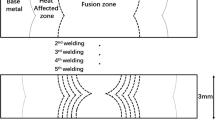Abstract
Finite element analysis (FEA) model of the solidification process in the cast pin tear test (CPTT) was developed using the commercial software ProCAST™. Modeling predictions of the solidification and strain accumulation sequences and of the cracking sensitive region location were validated using parallel CPTT testing of Alloy 52M filler metal. Predicted pin length dependences of the hot tearing indicator (HTI) and the effective plastic strain (EPS) were in good correlation with the experimentally determined zero to 100% CPTT cracking curve in Alloy 52 M. Sensitivity study with the developed model identified material properties and test parameters with strong influence on the accuracy of modeling predictions. Parallel computational modeling and CPTT experimentation was performed to quantify the critical strain for solidification cracking in Alloy 52M filler metal. This study demonstrated that numerical modeling of weldability tests can be used for quantification of material-specific properties related to cracking susceptibility in engineering alloys.











Similar content being viewed by others
References
Tomota Y, Daikuhara S, Nagayama S, Sugawara M, Ozawa N, Adachi Y, Harjo S, Hattori S (2014) Stress corrosion cracking behavior at Inconel and low alloy steel weld interfaces. Metall Mater Trans A 45(13):6103–6117
McCracken SL, Smith RE (2011) Behavior and hot cracking susceptibility of filler metal 52M (ERNiCrFe-7A) overlays on cast austenitic stainless steel base materials. Hot Crack. Phenom. Welds III, p 333–352
DuPont JN, Robino CV, Marder AR (1998) Modeling solute redistribution and microstructural development in fusion welds of Nb-bearing superalloys. Acta Mater 46(13):4781–4790
DuPont JN, Marder AR, Notis MR, Robino CV (1998) Solidification of Nb-bearing superalloys: part II. Pseudoternary solidification surfaces. Metall Mater Trans A 29(11):2797–2806
Engel R, Heldt J, Krause C (2013) Design and Analysis of a Full Structural Weld Overlay for a Feedwater Nozzle-to-Safe End Dissimilar Metal Butt Weld. Transactions, SMiRT-22, p Division VI
Mccracken SL, Tatman JK (2012) Influence of Austenitic Stainless Steel Base Metals on Hot Cracking Susceptibility of High Chromium Nickel-base Filler Metals. Proceedings of the 2012 ASME Pressure Vessels & Piping Division Conference, p PVP2012–78614 (1)–(11)
Ramirez J (2011) Understanding stress corrosion cracking of welds in nuclear reactors. Weld J 7:38–42
Cofie NG, et al (2008) Effectiveness of Stainless Steel Buffer Layer to Address Hot Cracking During Weld Overlay Repair of Dissimilar Metal Alloy 82/182 Welds with Stainless Steel Piping. Proceedings of 2008 ASME Pressure Vessels and Piping Division Conference, p PVP2008–61411 (1)–(10)
Hull FC (1959) Cast-pin tear test for susceptibility to hot cracking. Weld J 38:176–181
McCracken SL, et al (2010) Hot Cracking Study of High Chromium Nickel-Base Weld Filler Metal 52MSS (ERNiCrFe-13) for Nuclear Applications. Pressure Vessels & Piping PVP10, Paper PVP2010–25787, ASME, 2010(49255), p 879–889
Alexandrov BT, Lippold JC (2013) Use of the cast pin tear test to study solidification cracking. Weld World 57(5):635–648
Luskin TC (2013) Investigation of weldability in high-Cr Ni-base filler metals. The Ohio State Univeristy Thesis
Alexandrov BT, Lippold JC, Nissley NE (2008) Evaluation of weld solidification cracking in Ni-base superalloys using the cast pin tear test. In: Hot cracking phenomena in welds II, T. Böllinghaus, et al. Springer Berlin Heidelberg, Berlin, pp 193–213
Alexandrov B et al (2013) Susceptibility to solidification cracking in high chromium nickel-base filler metals for nuclear power applications, Trends in Welding Research IX, ASM International, pp 614–622
Dong H, Gao H, Wu L (2003) Numerical simulation of heat transfer and fluid flow in a double-sided gas-tungsten arc welding process. Proc Inst Mech Eng B J Eng Manuf 217(1):87–97
Niel A, Bordreuil C, Deschaux-Beaume F, Fras G (2013) Modelling hot cracking in 6061 aluminium alloy weld metal with microstructure based criterion. Sci Technol Weld Join 18(2):154–160
Wei YH, Dong ZB, Liu RP, Dong ZJ (2005) Three-dimensional numerical simulation of weld solidification cracking. Model Simul Mater Sci Eng 13(3):437–454
Dong ZB, Wei YH (2006) Three dimensional modeling weld solidification cracks in multipass welding. Theor Appl Fract Mech 46(2):156–165
Coniglio N, Cross CE (2013) Initiation and growth mechanisms for weld solidification cracking. Int Mater Rev 58(7):375–397
Safari AR, Forouzan MR, Shamanian M (2012) Hot cracking in stainless steel 310s, numerical study and experimental verification. Comput Mater Sci 63:182–190
Eskin DG, Suyitno, Katgerman L (2004) Mechanical properties in the semi-solid state and hot tearing of aluminium alloys. Prog Mater Sci 49(5):629–711
Zhu JZ, Guo J, Samonds MT (2011) Numerical modeling of hot tearing formation in metal casting and its validations. Int J Numer Methods Eng 87(1–5):289–308
Wang Z, Huang Y, Srinivasan A, Liu Z, Beckmann F, Kainer KU, Hort N (2014) Experimental and numerical analysis of hot tearing susceptibility for Mg-Y alloys. J Mater Sci 49(1):353–362
Luskin TC et al (2012) Preliminary Finite Element Analysis and Optimization of the Cast Pin Tear Test. in Numerical Analysis of Weldability X. Technische Universität Graz, Graz
Przybylowicz E et al (2016) Weldability evaluation of high chromium, Ni-base filler metals using the cast pin tear test. In: Boellinghaus T, Lippold JC, Cross CE (eds) Cracking phenomena in welds IV. Springer International Publishing, Cham, pp 269–288
Robino CV (2016) Engineering approximations in welding: bridging the gap between speculation and simulation. Weld J 95:1s–16s
Przybylowicz E (2014) Weldability evaluation of high-Cr Ni-base filler metals using the cast pin tear test. The Ohio State University, Columbus
Acknowledgements
This research was performed at the Welding Engineering Laboratory of The Ohio State University and was supported by Areva, AZZ WSI, Babcock & Wilcox Canada, Böhler Welding Group, the Electric Power Research Institute, and ESI Group North America. The authors acknowledge the technical support of Mr. Samuel Scott of ESI Group North America.
Author information
Authors and Affiliations
Corresponding authors
Additional information
Publisher’s note
Springer Nature remains neutral with regard to jurisdictional claims in published maps and institutional affiliations.
Recommended for publication by Commission IX - Behaviour of Metals Subjected to Welding
Rights and permissions
About this article
Cite this article
Wang, H., Alexandrov, B.T. & Przybylowicz, E. Experimental and numerical modeling study of solidification cracking in Alloy 52M filler metal in the cast pin tear test. Weld World 63, 913–924 (2019). https://doi.org/10.1007/s40194-019-00720-5
Received:
Accepted:
Published:
Issue Date:
DOI: https://doi.org/10.1007/s40194-019-00720-5




